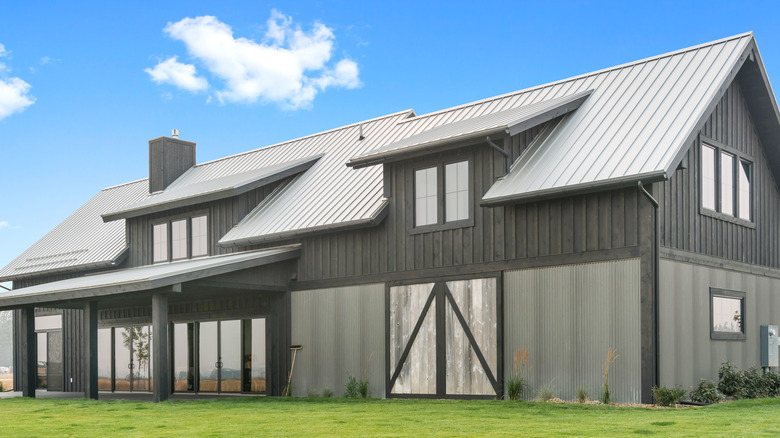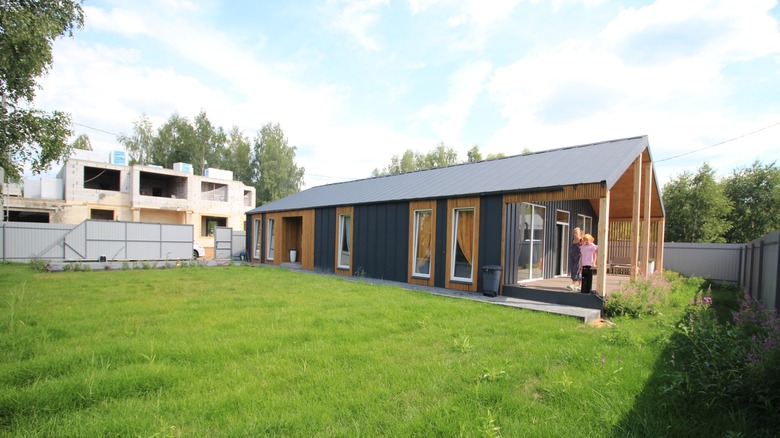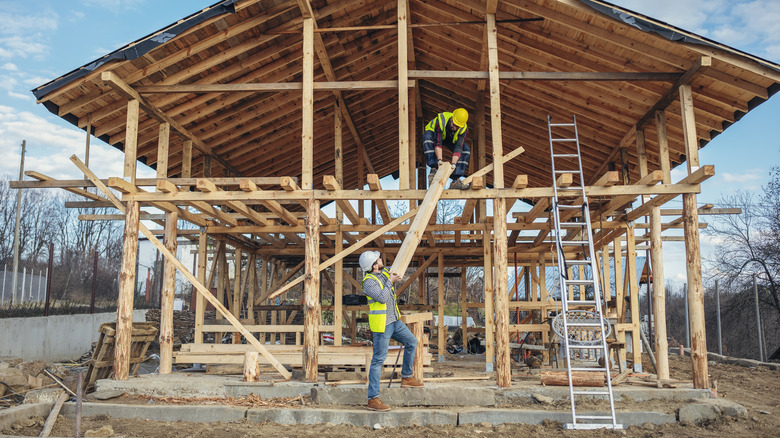Pros And Cons Of Barndominium Kits Before You Buy
Navigating the world of building materials can get confusing, and if you've been considering investing in a "barndo" or barndominium kit, you might wonder about the pros and cons of such a purchase. In an exclusive interview with House Digest, Matthew DiBara, 4th generation contractor and co-founder of The Contractor Consultants explained the perks and drawbacks of barndominium kits to help you get a better understanding of what you're getting should you choose this route. While the ease and convenience offered by these units are an obvious upside, building experience is necessary to ensure your construction is sturdy and sound when finished. Low-maintenance options are certainly a draw for many, but DiBara also notes that the flexibility and customization of these kits is limited.
According to DiBara, you can expect a variety of pieces to come with your barndominium kit. "The average barndominium kit includes the basic structural elements that will be used to form a house's exterior shell, items such as steel framing, metal siding, roofing material, windows, doors, and sometimes insulation. It may also contain blueprints or construction plans, which can act as your guide through the building process." All of these products are meant to help you construct a space that suits your lifestyle without the need for contractors, builders, and labor costs. Some kits also come with more extensive upgrades like plumbing and interior framing. "If you want to have a barndominium built fast and cost-effectively, then you will opt to buy a barndominium kit," he added.
Cost-effective but not the most customized options
DiBara explained that these kits vary in price. "The average cost for a simple barndominium kit will run from $20,000 to $90,000, depending on its size and inclusions. More elaborate kits, especially those including extra interior finishes or custom design work, may be quite a bit more expensive." While the extended kits can run higher, DiBara still notes that these are more budget-friendly. "The kits usually are going to be less expensive than traditional construction methods," he exclusively shared with House Digest in a recent interview. "They also sport faster build times since materials come pre-fabricated and pre-designed to fit together seamlessly. This leads to reduced labor costs and a quicker move-in date." DiBara adds that "...they are very tough and low maintenance, made of steel and other strong materials."
While the pros are tempting enough to encourage people to try out these kits, DiBara cautions that understanding the cons is equally important. "One major con is that there might be limited design flexibility compared to custom-built homes," he said when asked what the biggest drawback is. "That is, while kits allow customization in some sense, they may not hold the same level of personal design preference and/or intricate architectural feature options." DiBara feels potential buyers should know that "...piecing a barndominium kit together still requires quite an amount of skill and even labor. If none of the homeowners have construction experience, then it will be necessary to hire professionals, leading to increased costs."
Keep budget, skill level, and permits in mind
While cost is a pro, it's still helpful to know what to expect with varying degrees of construction. According to DiBara, "...the most expensive option is a completely custom-built barndominium. Depending on your materials, the level of detail, and the price of labor where you live, this may be $100 to $150 per square foot." When speaking to House Digest exclusively, he also shared that "... checking the land for suitability for building [including] the study of local zoning laws and obtaining necessary permits...is important to note [for] their budget [and] all extras: preparation of the site, labor, interior finishes, and utilities."
There are different options to consider, like converting an existing barn versus starting from scratch. DiBara noted that "When buying a barndominium kit, you are buying pre-fabricated materials and plans designed to easily assemble. On the other side, building a barndominium from scratch would include designing a structure from the ground up; this provides maximum customization but often comes at a higher cost and with longer build times."
He added that "Converting an existing barn into a barndominium can be a middle ground [because] it uses existing structures, which can help to save on building materials and labor costs, but it can need intensive renovations for residential becoming and requirements of modern living." He encourages interested parties to consider the skillset they bring to the project and to understand what comes in their kit before buying to avoid extra expenses.


